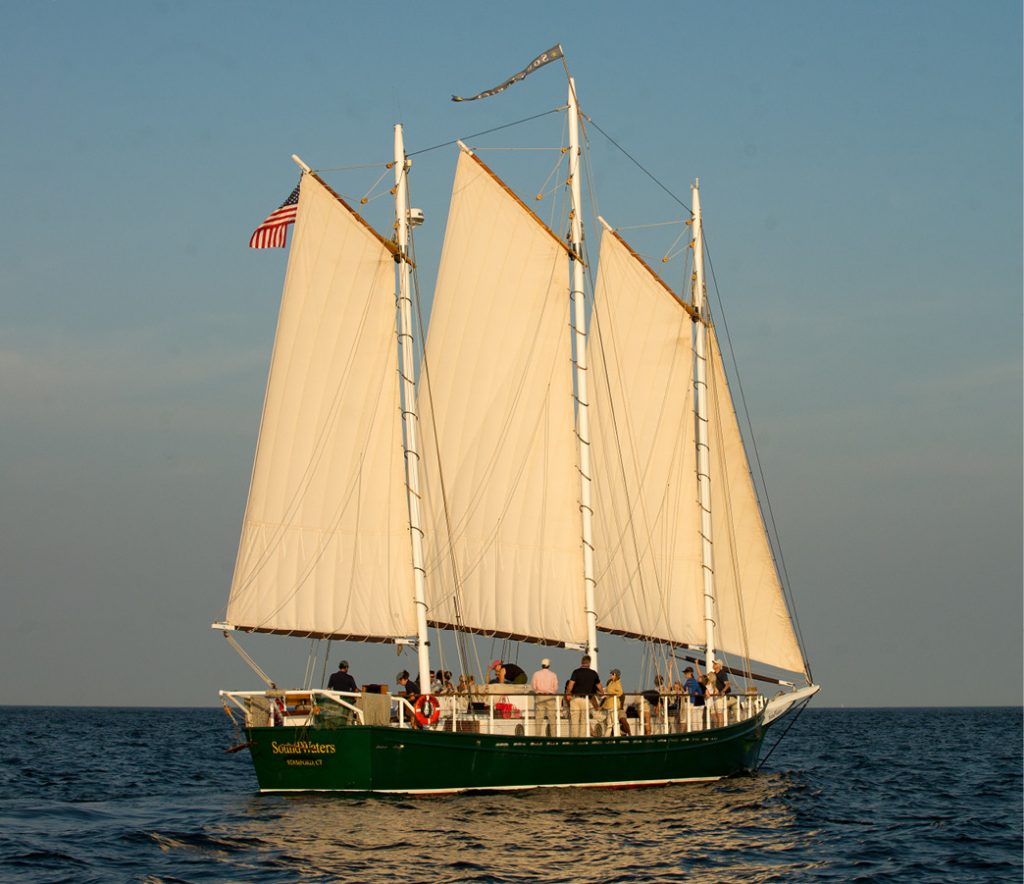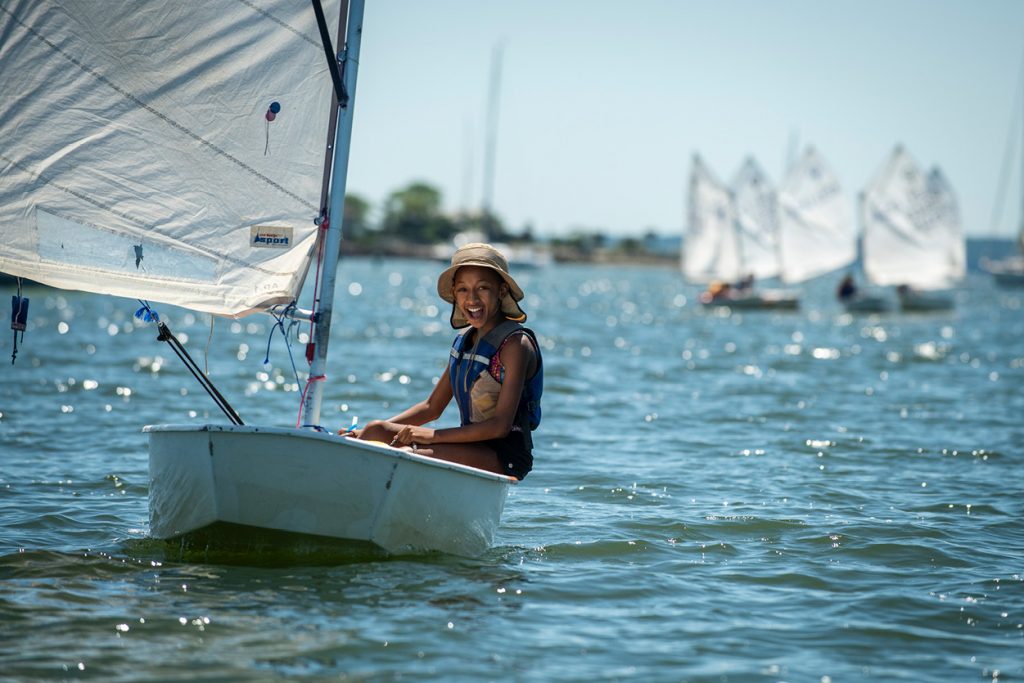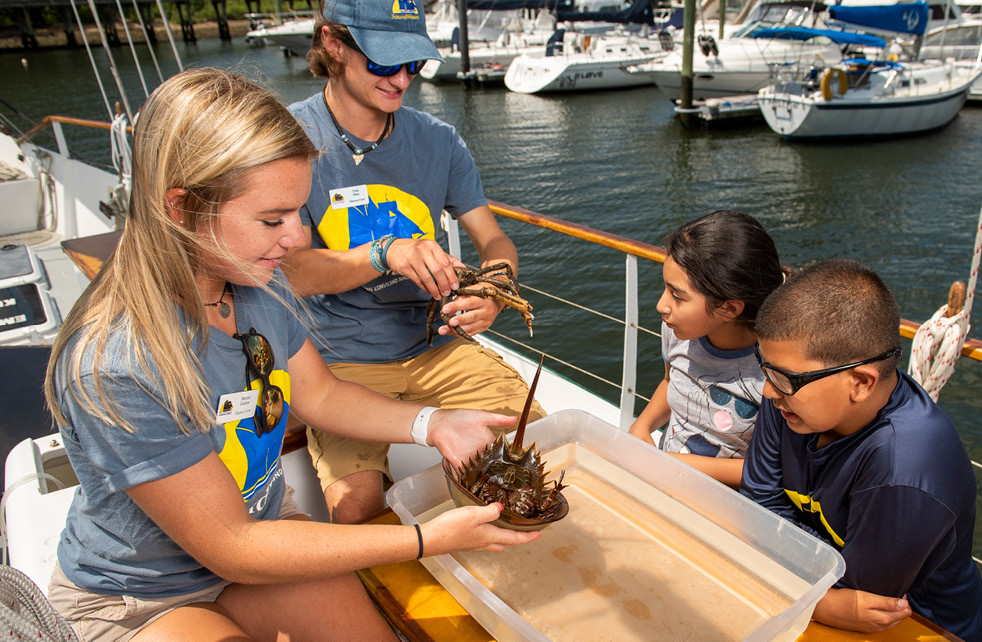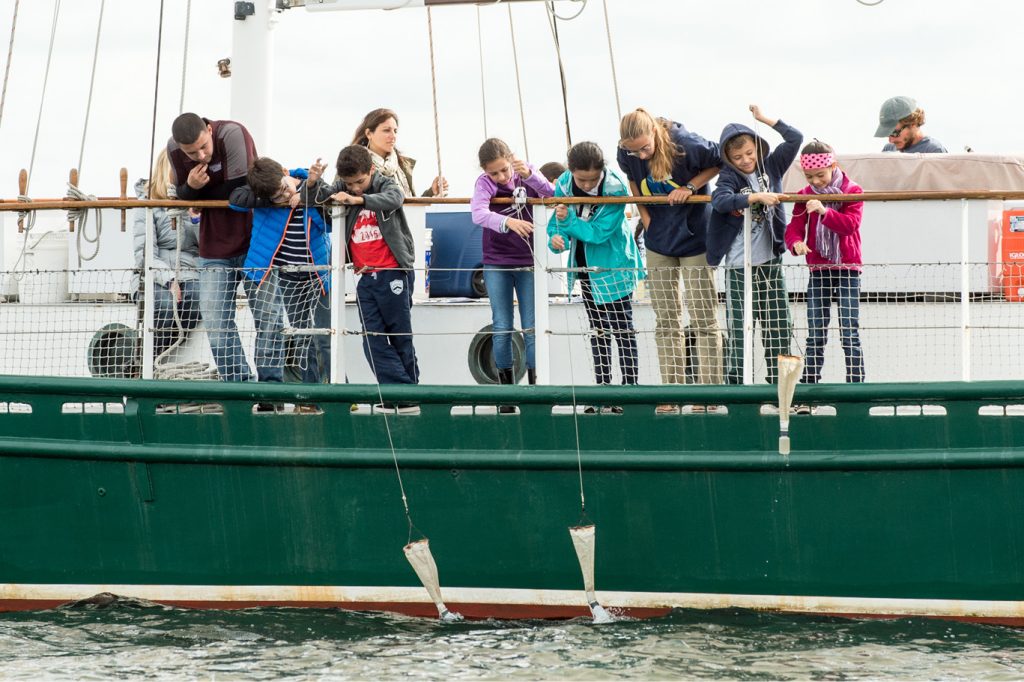SoundWaters knows that if they build it, they will come
By Rick Bannerot
How do you get – and keep! – kids interested in sailing? You need at least three elements to plot a direction, (and a fourth and/or fifth point on a chart so that you have a true path.) There cannot be a pattern with only two elements; in game theory and storytelling, it is called “The Rule of Three.” The answer to the question posed above is a large array of groups dedicated to youth sailing throughout the Northeast, and in particular Long Island Sound, operating under a variety of auspices which provide a veritable wealth of subjects to explore and highlight the many valuable points and keys to unlocking this process of learning to sail; and more importantly, learning to love sailing.

The 80-foot schooner SoundWaters is the floating classroom of Long Island Sound. © Mike Bagley/SoundWaters
Avid readers of WindCheck have ventured around the Sound in the past six months, exploring various sailing education programs that exist to get girls and boys into sailing, (i.e. “finding their salt”). One of the interesting newer pathways opening up is the teaching of adolescents the skills and joys of learning how to effectively, safely and competitively sail larger boats. This is part of a concerted effort to reduce the typical statistical fall-off between junior sailing and the time after college wherein lay the inevitable time and money constraints that come with finding jobs, getting married, having kids…the list goes on (and not always in that order).
One such successful example is Sea Scout Ship 6 in Norwalk, CT, a year-round, immersive scouting program that is essentially run by students for students in the Fairfield/Westchester corner of the Sound. (Profiled last month: windcheckmagazine.com/article/a-110-year-old-new-paradigm/.)
At the other end of the chart plotter is the more holistic approach to this premise embodied by SoundWaters (soundwaters.org), a 501(c)3 organization in Stamford, CT. Back in 1990, an idea emerged to have an 80-foot replica of a Chesapeake Bay oyster schooner become a floating classroom for teaching children hands-on marine biology, basic navigation and sailing skills, ecology and related sciences while sailing from port to port around the Sound, ultimately reaching over 6,000 kids aboard the ship each year.

This young sailor’s smile exemplifies the fun of learning in the Young Mariners program.
Within ten years, the iconic SoundWaters educational schooner program took a big new step. The SoundWaters Foundation accepted an offer by the City of Stamford to have a permanent, land-based location at the colonial Holly House (built 1791; National Historic Registry) on Holly Pond in Cove Park. With a new round of fundraising and grants from the City, they restored the house and renovated the interior space into offices, classrooms, and marine science wet labs that could remain active all year.
Public access to the Connecticut and New York shoreline of the Sound can be difficult given how much of the coast is privately held. SoundWaters is deeply committed to leveraging the natural environment and economic resources that the Sound has to offer the whole area, not so much as gatekeepers, but rather as advocates, facilitators, shepherds, and educators. SoundWaters’ coastal education programs and physical footprint proceeded to grow over the next fifteen years to include numerous marine conservation and science initiatives, and a public recreation spot that now involves 146 schools in 64 communities throughout the region, reaching more than 32,000 students annually.
In addition to promoting public access and appreciation for the Sound, another important tenet of SoundWaters has always been that costs should not predetermine who can or cannot participate in SoundWaters’ programs. Despite this charitable organization’s burgeoning enrollment and the growing scope of work, donors have always generously stepped forward to help underwrite SoundWaters’ cost to enroll and serve underserved and at-risk youth. Today, a remarkable 30+ percent of their students receive financial aid and scholarships!

Up close and personal with crabs at one of the education stations aboard SoundWaters © Mike Bagley/SoundWaters
On a related sailing note, as SoundWaters was growing beyond its roots as a floating classroom in the early 1990s, another program was in its early development stages as the Stamford Sailing Foundation’s “Blue Water Bound” junior sailing camp (subsequently changing its name to “Young Mariners” to better reflect its home waters, as the Sound is not exactly a deep blue like the Atlantic).
Participants were drawn from Stamford’s public schools and the Boys & Girls Club of Greenwich. The plan was to bring inner city youth to the waterfront, teach them how to swim, broaden their horizons by taking them out sailing, to ultimately teach them how to sail and instill an appreciation for all things salty.
The underlying premise was to eschew old educational wives’ tales and many long-held but questionable teaching processes. Young Mariners championed and celebrated the idea of developing a new and better game plan to game the system, improving the odds of success by using an outdoor educational “classroom,” like the Sound, to better effect. Education, provided through skilled public school teachers who loved sailing, deployed the best aspects of sailing discipline and excellence as detailed under the Young Mariners’ vision. This proved to be a new and exciting addition to enhancing reading skills, improving math competencies, and launching real world studies in marine and biology sciences.

Seine netting on the Sound © Mike Bagley/SoundWaters
Adding to the academic process is the incorporation of life lessons and the teaching of youngsters the importance of setting personal goals. Students in the Young Mariners program work on improving self-esteem through positive remedial school work, receive additional tutoring support as needed, do drills to build teamwork, refine decision-making skills through practical trial and error, and generate external local recognition for academic accomplishments in a nurturing and supportive environment. Oh, and most importantly, they seek to make learning more enjoyable by setting attainable goals while having fun achieving them. (If these elements seem familiar, they should; they’re all variations on the same themes underpinning the previous four junior sailing stories in WindCheck.)
The Young Mariners’ programs literally ran on shoestring budgets, limited public education funds, and the kindness of their donors. Heck, just getting to the Young Mariners campus required passing through the roughshod South End of Stamford to Bocuzzi Park where poorly-ventilated aluminum trailer classrooms awaited summer campers. Modest docks and boat racks were filled with very tired Optis and Lasers. (Many experienced sailors would have judged these boats “beyond repair,” but rather than consigning hulls to the chainsaw and dumpster, a lot of sweat equity, skilled hands, and a bosun’s knowing touch yielded a few more years’ use.)
Most sails were softer than an 800-thread count Egyptian cotton bedsheet and coach boats were mostly decades-old donated Boston Whalers with old fire hose screwed into the gunwales for fenders! To say the PFDs were “a little musty” would be too kind. However, despite these many challenges, what wasn’t the norm were the huge smiles on the faces of young sailors, camp counselors, and the staff running the program. Nobody was looking the gift boats in the bilges – they were having too much fun learning and learning to sail.
To give you an idea of the impact of Young Mariners had on young sailors, by 2015, over 2,300 underprivileged students from 5th-12th grade went through the program. Test results were equally impressive: first-year campers were given a science-based curriculum and achieved a 77% increase in test scores. Second-year campers were given a math curriculum with some review of science material from the previous year, and had a 64% increase in their scores. Third-year students were placed in a research-intensive program based on the Connecticut State Standards in Social Studies and saw a 153% increase in their test scores. (source: US Sailing Newsletter, 3/9/15).
In what proved to be a little bit of kismet, a healthy dash of local politics, and the results of the seismic economic shifts in Stamford’s waterfront real estate and ongoing urban redevelopment, Young Mariners and SoundWaters merged in 2016. SoundWaters’ Cove Island “campus” is situated facing north on Holly Pond, and is perfect for canoes, kayaks, SUPs and Optimist dinghies. But at low tide, it’s not so good for anything with even a modest centerboard. Meanwhile, the Young Mariners program found itself constrained by the size and condition of its trailers and storage arrangements. The March 2016 issue of WindCheck summarized the event as:
“The partnership [with SoundWaters] intends to revitalize Boccuzzi Park over the next three years, converting the Young Mariners Foundation property into a robust ecological and economic zone, and upgrading and expanding the Harbor Center in the Waterside section of Stamford Harbor into a flourishing educational center and sailing facility for adults and students alike. (windcheckmagazine.com/article/soundwaters_and_young_mariners_merge/)
By 2020, SoundWaters had replaced many of the most decrepit Young Mariner boats, and put in some much-needed repairs to the marine side of the property. With better sailing facilities and a new footprint on the western part of Stamford Harbor, four miles from Cove Pond, and with their vision for the Young Mariners’ campus, SoundWaters excitedly announced in April of 2021 that they were in receipt of a $3 million bequest from the Steven & Alexandra Cohen Foundation to support the building of the Cohen SoundWaters Harbor Center at Bocuzzi Park.
Currently under construction, the Harbor Center is slated for a soft opening later this summer, and should be fully functional in 2023. The new 12,000+ square foot building will have tech-enabled classrooms with moving partitions to accommodate different size classes, marine biology wet labs, aquariums, plus a full working wood shop and metal shop for marine technical trade training.
Michael Bagley, VP of Programs for SoundWaters and Young Mariners, said the current summer sailing program is for 6th-9th graders from June 23 to July 22, and is taught by four Stamford elementary school teachers who are also certified US Sailing instructors. “They bridge the classroom portion of the learning program with the sailing instruction,” Bagley explained, “finding unique ways to bring the experience of sailing on Long Island Sound together with the math and science the young sailors learn in the classrooms and vice versa.”
Given the limitations of the old Bocuzzi Park campus, Bagley expects that in the next couple of years, high schoolers will be added back into the Young Mariners as the new building gets up and running. Just as the curriculum is holistic, so too must be the educators. Bagley is clear that they need more teachers that are certified sailing instructors to replace the current teachers as they begin to retire. He added, “We are at an exciting inflection point with big plans, and we have some big teaching needs, but we are in the process of building upon great programs.”

The Cohen SoundWaters Harbor Center will be a state-of-the-art learning facility. © Wladyslaw Prosol
The Cohen Foundation’s anchor gift jumpstarted SoundWaters’ Harbor Ambitions Campaign, which includes the Cohen SoundWaters Harbor Center building, according to Bob Mazzone, VP Development for SoundWaters. “Significant donations beget significant donations, and we are absolutely leveraging this financial momentum to get matching grants, private donations of all sizes, as well as city and state financial investment in Bocuzzi Park, and the new maritime facilities. We are approaching $13 million in hand, and have another $5 million pledged in estate planning gifts over the next twenty years.”
He added, “Our key initiatives include expanding Young Mariners beyond a summer focus to also include high schoolers, and ramping up our technical maritime trade skill training to year-round use. It is one thing to educate people about Long Island Sound. It is an altogether different experience if you can get them wet and salty when they are young.”
Mirroring Mazzone’s comments, SoundWaters’ President Leigh Shemitz said, “As a vital access point to the wonders of Long Island Sound, we look forward to seeing what the future has in store for the girls and boys we’ve reached through our SoundWaters initiatives. It is our duty to create respect and understanding, to make good choices, and to build an appreciation for what an amazing resource we have here.”
“For me,” Bagley added, “sailing is the perfect platform to teach these life skills, and to challenge the next generation to do even better by this salty piece of water. If you don’t know it, you won’t love this precious marine resource.”
When it comes to the future of sailing and where the next batch of sailors will come from, the chart plotting shows a clear pattern of success, a healthy dose of good decision-making, a commitment to a healthy future, and an emphasis on making learning fun. SoundWaters and the Young Mariners program are well underway when it comes to bringing onboard an exciting new generation of sailors who will know and appreciate the rich resource that is Long Island Sound. And to the sailing waters beyond, who knows? It won’t be long before the new generation of young mariners will likely be bluewater bound. ■
